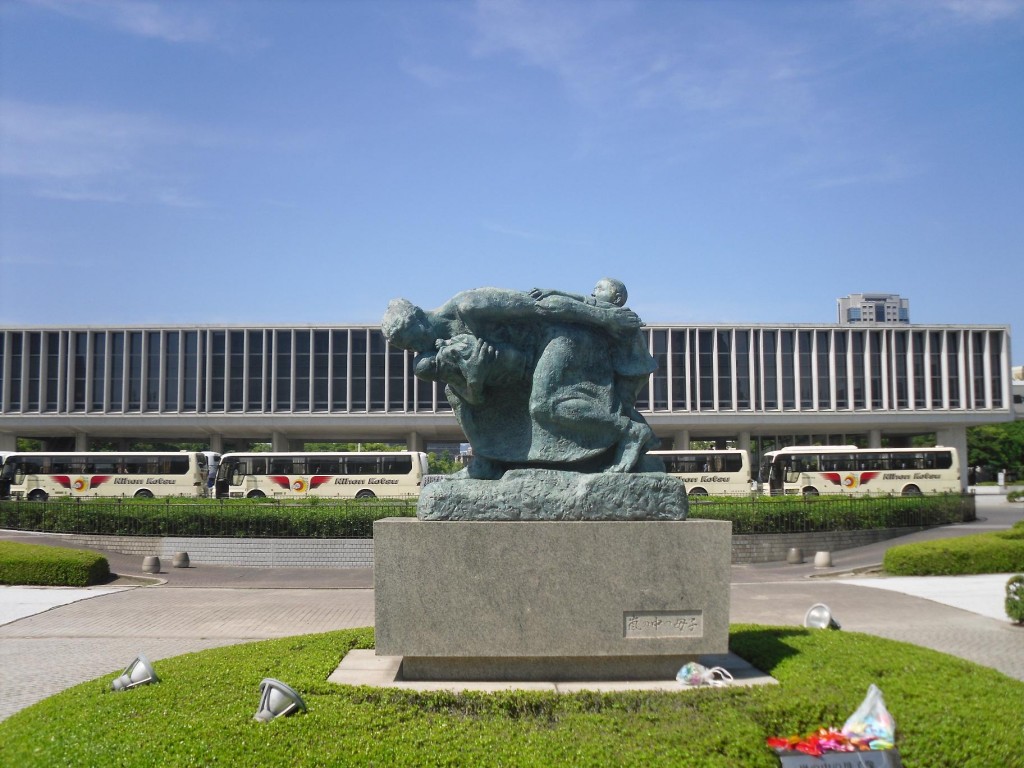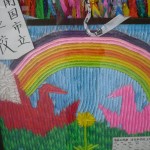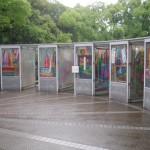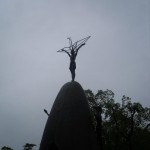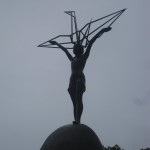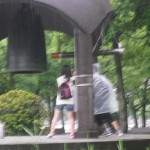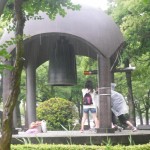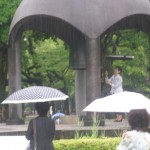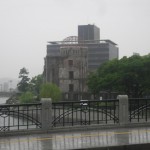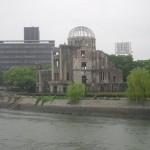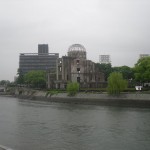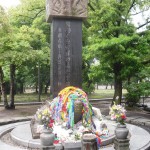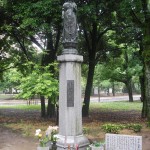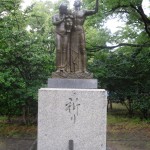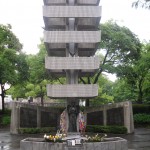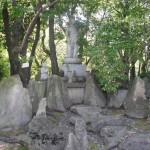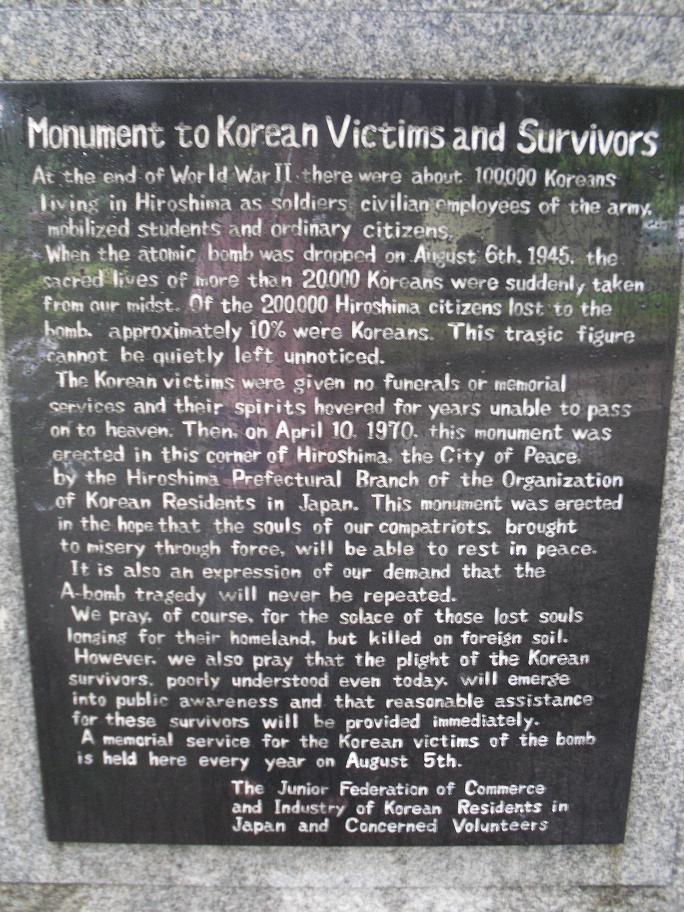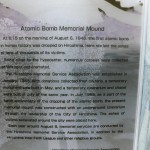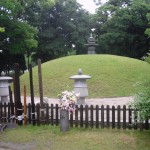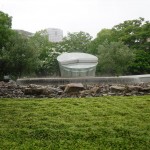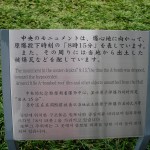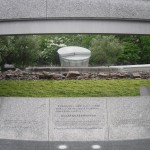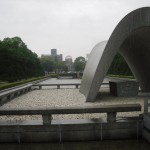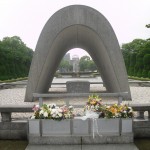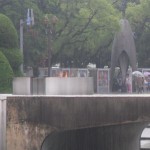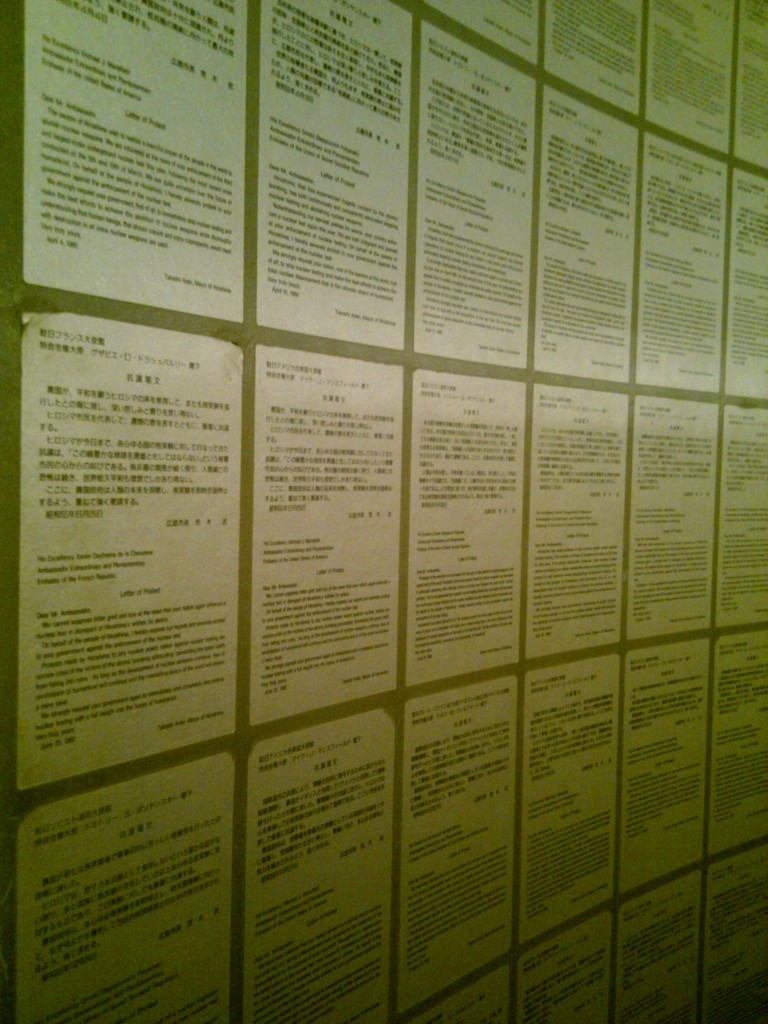Having left the hostel I walked slowly wandering in the direction of the peace memorial as the rain fell heavily. While walking in the general direction of the memorial I had heard a large bell ring in the distance. I had told myself at the time that the bell had to be from some temple or church that was off in the distance.
I kept walking until I stumbled upon the first monument which was a statue dedicated to the child victims of Hiroshima: The children’s peace monument. This is a moving monument to experience when you stop to consider that many of the causalities from the a bomb were children.
From Wikipedia: “The Children’s Peace Monument is a statue dedicated to the memory of the children who died as a result of the bombing. The statue is of a girl with outstretched arms with a folded paper crane rising above her. The statue is based on the true story of Sadako Sasaki (佐々木禎子, Sasaki Sadako?), a young girl who died from radiation from the bomb. She believed that if she folded 1,000 paper cranes she would be cured. To this day, people (mostly children) from around the world fold cranes and send them to Hiroshima where they are placed near the statue. The statue has a continuously replenished collection of folded cranes nearby.”
From there I followed the river bank in order take a few quick shots of the A bomb building that I could see in the distance. I told myself I would take a few quick shots from far away and then I would cross the river bank and get some clearer pictures on the way back to the hostel. It was while following the river bank to snap a picture of the A dome building that I once more heard the loud deep resonating sound of a bell, only this time it was being generated very near to where I was. I looked around and saw a group of individuals not far from where I was surrounding an elevated bell as I approached.
There’s a sign in front of the bell that invites visitors to the park to ring it as a declaration against war. That it’s resonating sound may be a reminder of the atrocities committed and a shout for peace. It’s hard not to feel moved by such things and wandering the park by myself on a dark rainy day made the experience one that I’ll never forget.
I got the impression that most days the park is full of tourist. With the rain falling heavily and no one around I walked up to the bell and rang it once loudly. Seeing the A dome building across the river while the bell continued to resonate left it’s mark on me.
While wandering the park in the rain you could hear the bell toll at random intervals as various tourist walked up to profess their declaration for peace. The ringing was both soothing and saddening. I was already a little depressed about having left Tokyo and ringing the bell by myself in the pouring rain was much more emotional than I had expected. You’re standing on ground where nearly 70000 people were snuffed out and died instantly. Many more in the following days, weeks and years after ward.
I then turned around and continued to investigate the memorial park wandering randomly. I stumbled upon many of the memorials dedicated by various communities and countries.
One that stuck out for myself was the Korean memorial. Many of the victims of the Hiroshima Atom bomb were Koreans, used as slave labor during the war. They went unrecognized for years. It was only several years after the Korean memorial had been erected outside the park that it was moved into the memorial park. The memorial in question is included in the set above and is the picture with all the paper cranes at it’s base:
Continuing to walk randomly through the park I discovered the burial mound which contain the ashes of unidentified victims of the bombs. When you take in the size of the mound you realize just how many ashes must be in place in order for it to be so large.
After having wandered the park for an hour or so I eventually made my way to what I believe is called the frozen in time monument: a large concrete clock frozen at 8:15, the time that the bomb dropped. Included all around it was rubble from various buildings that hadn’t survived the blast. I’m not certain if it was due to the rain or humidity but a light mist was rising from the fountain surrounding the monument. I’d recommend taking the time to click on the pictures to see a larger view of it.
Before entering the Museum I made one last stop to the cenotaph. I myself didn’t know what a “cenotaph” meant and had to look it up once I got into the hostel. As wikipedia explains:
“A cenotaph is a tomb or a monument erected in honour of a person or group of persons whose remains are elsewhere…Although the vast majority of cenotaphs are erected in honour of individuals, many of the best-known cenotaphs are instead dedicated to the memories of groups of individuals, such as the war dead of one country or empire.”
Through the cenotaph you can see the flame and the a dome building. The flame will only be extinguished when the last nuclear bomb is eradicated. If you ask me it’s already been burning much too long yet at the same time I’m a realist. It’ll probably be burning for several more generations as we continue to draw lines in the sand…
As the last remaining victims of the bombings die (most of whom were children in the womb at the time), their names are added to the list on the cenotaph…
I proceeded to enter the museum and work my way through the exhibit. I only snapped a few pictures of the museum. This was of my own choice as photography is permitted. The museum is extremely moving and powerful. Some of the pictures and exhibits are hard to look at and experience. The complete and utter devastation caused by one the atomic bombs is truly heart breaking, unbelievable and mesmerizing all at the same time.
During most of my trip I’ve been wandering the various cities by myself. Loneliness doesn’t come over me often but in Hiroshima it swept over me. I was approached by an old man at the museum who I assumed to be Japanese . He had a smile on his face and proceeded to ask me question. If i’d have to guess he was probably old enough to be a veteran of WWII. Understanding absolutely no Japanese, I tried to explain that I was Canadian by pointing to myself and saying Canada. This didn’t seem to bother him at all as again he continued to speak to me in Japanese. Eventually I pulled out my phrase book and pointed to the sentence “I’m sorry I don’t understand Japanese”. He smiled and continued on with the rest of his tour.
I would of loved to have had a guide or a Japanese friend who could of translated what he was asking me. For all I know he was asking me if i was cold from the rain. Having been approached by him it bothered me that we weren’t able to communicate.
The hardest part for myself was seeing the drawings of the survivors, many who were young at the time. A television program had requested that survivors of the bombings send it a picture of their memories. Many of the hand drawn pictures were of no artistic value (stick figures, drawn like a child). What was incredibly powerful were the vivid colors and descriptions including them. The one common thing in most of them were corpses, walking or dead, fire and blood.
Descriptions such as “the black marks are bodies, but if I drew as many as I had seen the page would be all black”. You can see some of these pieces of history here. If that link stops working try this one, which redirects you to a basic google search for Hiroshima survivor drawings. Words truly cannot describe the impact these pictures left on me.
Another of the exhibits that really struck me we’re individual letters (copies of telegrams) sent to the presidents of countries who had completed atomic testing. One letter for each test had been sent by the mayor of Hiroshima to the president of the country in question. Each letter had been translated in English and included on a wall. The letter deplored the fact that they were doing nuclear testing and working towards nuclear armament. It asked the president of the country to consider the consequences of their actions. When seeing the amount of letters covering the walls you couldn’t help but be moved.
On my first day wandering the city and with the rain falling heavily it was very easy to imagine what the toxic rain must of been like that horrible night. After the bombing radioactive clouds unleashed a dark black rain from above Hiroshima and it’s neighboring areas. The rain being radioactive and extremely harmful it was none the less swallowed by many survivors desperate for any kind of water.
Most individuals have experienced a sunburn of some type in their lives. If you have then you know how the “heat” of the burn radiates and can be felt on the skin. Many survivors of the bomb were burnt by the radiation in a similar way to a sunburn. The only difference being that it was several thousands if not millions of times more severe than a sunburn. These victims wandered the streets as living zombies (as described by survivors) crying out for water. Badly burned, missing limbs, unable to talk; The survivors were told not to give them any of the water. Whether from the wells or the rain as it would kill them. Many still struggle with the screams they heard those first few nights. The echoes of the walking dead crying out for water still echoing in their dreams from so many years ago.
At the museum in pictures and in the drawings in the link provided above, many of the victims have parts of their bodies burnt to a crisp. These were the parts exposed to the radiation when the bomb went off. One particularly vivid memory from a survivor talked about when they walked by a well that was filled with bodies. Desperate victims trying to quench their thirst had jumped in until it was completely filled…
Its easy to forget Hiroshima’s past when the sun is humming brightly. Maybe it’s because of my state of mind that I haven’t really been able to enjoy myself while here. My thoughts keep going back to some of the things at the museum and the suffering that the citizens of Hiroshima endured.
If you didn’t know better you could easily walk through this city and forget what occurred here over sixty years ago. The citizens have luxury goods and cars. They go about their days with a certain platitude towards the various tourist wandering their city. It feels vibrant and metropolitan: At night young artist play guitars or classical Japanese string cord instruments. The citizens go out, eat, drink and live life to the fullest. It’s definitely the city in which I’ve seen the most foreigners while in Japan. That being said I got the impressions that most Westerners that visit this city do not do it alone. I got the occasional glance or look while walking on the streets, which for Japanese people is out of the ordinary based on my experiences.
I think it would make for amazing footage to have groups of soldiers from various nations walk through the peace museum and film their reactions from entrance to exit….
There are two sayings that have remained with me since visiting the museum. Those are “world peace begins at Hiroshima” and “Cities are not targets”. Anyone who has visited the museum understands why.
The next day I went in search of one statue that I had missed during my initial visit to the peace memorial. It was that of a mother sheltering one of her children from the radioactive black rain. I wish I would of taken this picture on my first day at the park because I think it would of been more moving to capture this statute while the rain was pouring down on it. None the less it leaves a powerful impression.
